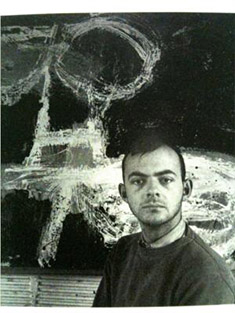| Cy Twombly | |
|---|---|
 |
|
| Born | April 25, 1928 Lexington, Virginia, United States |
| Died | July 5, 2011 (at age 83) Rome, Italy |
| Nationality | American |
| Education | School of the Museum of Fine Arts, Boston Washington and Lee University Art Students League of New York Black Mountain College |
| Field | Painting, sculpture, calligraphy |
| Works | View Complete Works |
Cy Twombly (1928- 2011) was a painter, draftsman, sculptor and a photographer. He was American. His work crosses the major issues of art in the twentieth century to include dilemma abstraction / figuration, the intervention of psychoanalysis, primitivism, the role of writing in painting, tribute to the former (he often chooses his themes in antiquity or in ancient literature) and the artistic links between Europe and America.
At a very young age, Cy Twombly got interested in drawing and painting. In 1940, he followed the painter Pierre Daura, a Spanish artist (former student of Picasso’s father). He moved to Rome, where he met a Virginian, and they married in New York.
Career
In 1946, Twombly joined the Darlington School in Rome, Georgia. He spent the summer of 1947 with an artists’ colony in Ogunquit and Groveland. Then he studied at the University of Lee Lexington before joining the Art Students League of New York in 1950. This is where he met painter Knox Martin and Robert Rauschenberg. On the advice of the latter, he lived at Black Mountain College, near Asheville, North Carolina, a place for exchanges and meetings where the intellectual avant-garde of New York came together.
His first exhibition was presented in 1951 by the Kootz Gallery in New York. A grant from the Museum of Fine Arts, Virginia in 1952 allowed him to take a trip to Europe, Spain, Italy, France and North Africa. Back to the United States in 1953, Twombly joined military service as a cryptologist. He worked in New York and befriended Jasper Johns and acquired a reputation. In 1959, he moved to Italy where he found the country conducive to its creations.
Works
Since the year 1962, he has produced a series of works on historical subjects such as Leda and the Swan. Like The Birth of Venus, Leda and the Swan, was the most often painted theme of Twombly’s work of early 1960s. From 1960 to 1963, Twombly painted Leda’s rape by Zeus/Jupiter in the guise of a Swan six times, once in 1960, twice in 1962 and three times in 1963. This indicated Twombly’s inclination towards mythological creatures.
Eroticism became more evident. From 1967 to 1971, he produced a huge number of grey paintings, to include colorless reminiscent of chalk on a blackboard, that form no real words. Twombly did this work with an odd technique: he sat on the shoulders of a friend, who shuttled the length of the canvas, allowing him to create his work. In 1971, Twombly painted the elegiac Nini’s Paintings to pay tribute to Nini Pirandello, who suddenly died and was the wife of a Roman gallerist. Often working on paper, Twombly combined various techniques: crayons, oil paint and pencil. He made the curtain of the Opera Bastille (Paris) in 1989.
Retrospectives
In 1968, the Milwaukee Art Center mounted his first display. Thereafter he had a number of retrospectives worldwide. He had been honored at Kunsthaus Zurich in 1987, Musée National d’Art Moderne in Paris in 1988 and Museum of Modern Arts in New York in 1994. The Neue Pinakothek, Munich also has a large number of his works. In 2001, Twombly was asked by Szeemann, the director of the Venice Biennale, to propose an exhibition on the theme “The foundation of human being.”
In a career spanning more than half a century Cy Twombly depicted the conceptual elegance and exquisite use of the techniques of painting and sculpture that have been discovered and developed in modernity without neglecting literary and historical wealth. He is one of the greatest artists of the genre of abstract expression. In one of his most recent cycles, the cycle of the rose, Twombly rediscovered the use of color, surprising everyone with green and orange psychedelic.
A few months before his death on July 5, 2011, he asked to be buried in Rome, the city that he loved so much and had chosen as his homeland since the late ’50s. With the death of Cy Twombly, art history lost one of its greatest protagonists and a painter of experimentation and emotional intensity.
Written under the U.S. laws, Twombly’s will gave a huge portion of his art and wealth to the Cy Twombly foundation of New York. Today, this foundation controls Twombly’s work. With the efforts of the foundation, an Arts mansion is recently going to open in late 2012 as an exhibition and study center.
His loss is an irreparable damage to the world of art and it would take decades to fill the vacuum created.